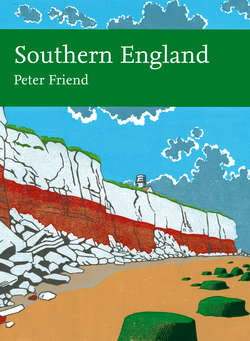Читать книгу Southern England - Peter Friend - Страница 29
Crustal convergence that created the mountain belt
ОглавлениеThe subsidence and sedimentation were sometimes interrupted by, and generally followed by, episodes of convergence of the Earth’s crust. This was caused by compression or squeezing, broadly in a north-south direction, so that areas of bedrock were folded and pushed closer together, making the east-west trending Variscan belt narrower, as if between the jaws of a vice. The map (Fig. 39) and cross-section (Fig. 40) show how the folds and faults of the region vary locally in their pattern, but can be explained generally by convergent movements in this north-south direction. These continued over at least 100 million years, and occurred along thousands of kilometres of the belt. Mountain-building events such as this occur when tectonic plates collide (as described in Chapter 3) and always have a profound effect upon the scenery in the vicinity of the collision. The Variscan mountain belt is just one of the great mountain-building episodes that have occurred periodically, throughout the Earth’s history.
FIG 36. Timeline diagram showing bedrock deposition and emplacement events in the Southwest Region.
Some of the best evidence for the horizontal crustal shortening comes from examining folds that can be seen in the bedrock at many localities (Figs 41 and 42). Folding of the originally flat layers of the bedrock is a spectacular feature of many southwestern sea cliffs, and the direction of the folding gives a clear indication of the direction of the shortening that resulted. Fractures (faults) also frequently cut the bedrock, and careful mapping makes it possible to recognise that, although some of them are very local features, others turn out to have been flat-lying fractures across which many kilometres of movement have taken place.
FIG 37. Simplified geological map of the Southwest Region.
FIG 38. Typical Devonian sedimentary basin in the Southwest Region.
FIG 39. The major bedrock structures of Southwest England and South Wales.
Another feature of the mountain building is that muddy material – the most abundant sediment in the Southwest Region – was often converted into slates that can typically be split into thin sheets and are said to possess a ‘slatey cleavage’. These rocks are locally referred to as killas, to distinguish them from other rocks with no cleavage, particularly the granites. The conversion into slates took place during the folding and fracturing of the mountain building, when the original muds, rich in clay minerals, were buried deeply below other sediments and then compressed to produce a new layering (or cleavage).
One large feature visible in the bedrock is the ‘Culm fold belt’ or ‘synclinorium’, a large and complex downfold representing horizontal crustal convergence (Figs 39 and 40). The centre of this feature is a belt of bedrock of Carboniferous age that extends between Bude and Exeter running across the centre and north of the Southwest Region. To the north and south of this, older (Devonian) rocks occur at the bedrock surface, forming the margins of the large downfold or syncline (Fig. 37). Culm is an old term much used by miners and European geologists for Carboniferous sediment, and synclinorium is a name for a downfold (or syncline) which contains numerous smaller folds.
In the Lizard area, much of the bedrock consists of a distinctive group of igneous rocks (Figs 39 and 40). These rocks cooled and solidified earlier than the main mountain building, and were mostly formed by intrusion of hot molten rock in a way that is typical of the floor of an ocean basin. The Lizard area provides one of the best examples now visible on land in Britain of material formed originally as ocean-floor crust. In Late Devonian times, as a result of early Variscan convergence, this large area of oceanic crust was forced northwards over and against sedimentary rocks lying just to the north. This shows how, in a large mountain belt, an area of crust (tens of kilometres across), with a distinctive history as the floor of an ocean basin, can be uplifted and incorporated into a mountain belt as its margins are squeezed together.
FIG 40. Schematic cross-section representing major structures of the Variscan mountain belt. The deep structure shown is speculative but shows how crustal shortening seen at the surface may be related to deeper, flat-lying fractures (faults). Located on Figure 39.
FIG 41. Zigzag folding due to horizontal convergence during the Variscan mountain building is spectacularly exposed at Hartland Quay (Area 3). (Copyright Will Brett/www.lastrefuge.co.uk)
FIG 42. Zigzag folding due to horizontal convergence during the Variscan mountain building, this time at Bude (Area 2). (Copyright Dae Sasitorn & Adrian Warren/www.lastrefuge.co.uk)
Some of the bedrock of this Lizard Complex is called serpentinite, after the common occurrence of the green mineral serpentine in sinuous cracks and veins. This gives the rocks an attractive colour patterning, and the absence of quartz makes them surprisingly easy to work with steel tools, giving rise to a local industry of carving serpentinite ornaments.
